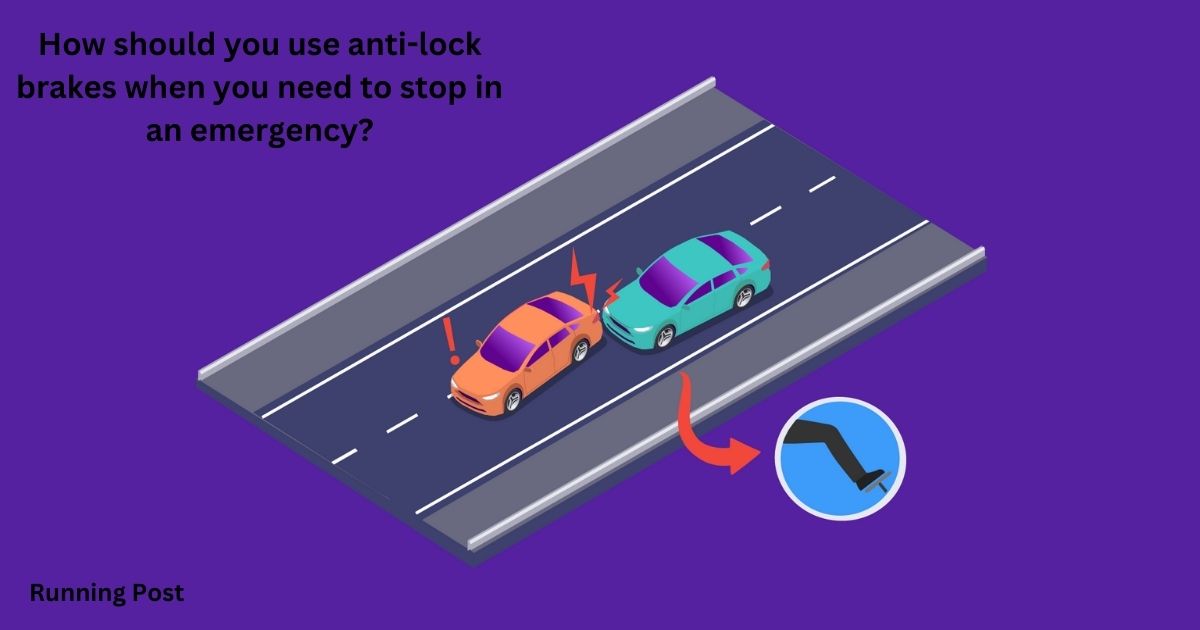| A: Brake normally but grip the steering wheel tightly | B: Brake promptly and firmly until you’ve stopped | C: Keep pumping the footbrake to prevent skidding | D: Apply the parking brake to reduce the stopping distance |
Understand How should you use anti-lock brakes when you need to stop in an emergency?
Introduction
Anti-lock brakes (ABS) have become a standard feature in modern vehicles, playing a crucial role in ensuring safety during emergency situations. ABS technology prevents the wheels from locking up during hard braking, allowing drivers to maintain steering control and avoid skidding. This is especially important in emergencies when quick and decisive action is needed to avoid collisions.
Understanding how to effectively use ABS can make a significant difference in the outcome of an emergency stop. It’s not just about pressing the brakes; it’s about knowing the right technique to apply and maintaining control of your vehicle. In this article, we’ll explore the fundamentals of ABS, the proper use of anti-lock brakes, and additional braking techniques to ensure you’re well-prepared for emergency situations.
Importance of Anti-Lock Brakes (ABS) in Emergency Situations
Anti-lock brakes are designed to enhance safety by preventing wheel lock-up during hard braking. In critical situations, where sudden stops are necessary, ABS helps maintain traction and steering control. This is particularly valuable on slippery surfaces such as ice or wet roads, where the risk of skidding is higher.
ABS operates by rapidly pulsing the brakes to prevent the wheels from locking up. This pulsing action allows the driver to steer around obstacles even while braking hard. By keeping the wheels from locking, ABS helps prevent the vehicle from skidding out of control, reducing the likelihood of accidents during emergencies.
In essence, ABS transforms emergency braking from a potentially hazardous maneuver into a more controlled and safer action. Understanding its function and proper usage can greatly improve your response in critical moments, making ABS an invaluable safety feature in any vehicle.
Overview of Anti-Lock Brakes Technology
Anti-lock brakes (ABS) are an advanced safety feature integrated into modern vehicles to prevent wheel lock-up during intense braking. The core technology behind ABS involves a system of sensors, control modules, and hydraulic components that work together to ensure optimal braking performance.
The system is equipped with wheel speed sensors that continuously monitor the speed of each wheel. If the system detects that a wheel is about to lock up, it modulates the brake pressure to that wheel to prevent it from skidding. This modulation occurs rapidly and repeatedly, allowing the driver to maintain control and steering ability even under heavy braking conditions.
ABS technology has evolved over the years, with newer systems offering additional features such as electronic stability control (ESC) and traction control systems (TCS). These enhancements further improve vehicle stability and safety during various driving conditions, making ABS an integral part of modern automotive safety systems.
Understanding Anti-Lock Brakes (ABS)
What Are Anti-Lock Brakes?
Anti-lock brakes (ABS) are a safety feature designed to prevent wheel lock-up during emergency braking situations. Unlike traditional braking systems that might cause the wheels to lock and skid, ABS uses a system of sensors, valves, and control modules to modulate brake pressure and maintain wheel rotation. This technology ensures that the driver retains steering control while braking, reducing the risk of skidding and loss of control.
ABS works by detecting when a wheel is about to lock up and adjusting the brake pressure to that wheel accordingly. This process is done rapidly and continuously, allowing the driver to apply maximum braking force without losing traction. By preventing wheel lock-up, ABS enhances vehicle stability and helps drivers avoid obstacles during emergency stops.
How ABS Works
Anti-lock brakes operate through a sophisticated system that includes wheel speed sensors, a hydraulic control unit, and an electronic control module. The wheel speed sensors monitor the rotational speed of each wheel and send this information to the electronic control module. If the system detects that a wheel is slowing down too quickly and is about to lock up, the control module adjusts the brake pressure through the hydraulic control unit.
The hydraulic control unit contains valves that modulate brake pressure, allowing it to be increased or decreased as needed. This modulation happens rapidly, often at a rate of several times per second, to prevent the wheels from locking up. The driver may feel a pulsing sensation in the brake pedal, which is normal and indicates that the ABS system is actively working to maintain traction and control.
Proper Use of Anti-Lock Brakes
Brake Promptly and Firmly Until You’ve Stopped
When using anti-lock brakes during an emergency, the key is to brake promptly and firmly until the vehicle has come to a complete stop. ABS is designed to handle hard braking and prevent wheel lock-up, so it’s important to apply the brakes with full force. This ensures that you achieve the maximum stopping power while maintaining control of the vehicle.
Many drivers mistakenly believe that they should pump the brakes or release them momentarily to avoid skidding. However, with ABS, you should apply consistent and firm pressure. The system will automatically modulate the brake pressure to prevent wheel lock-up, allowing you to steer and maintain control even under intense braking conditions.
Why Prompt and Firm Braking is Crucial
Prompt and firm braking is essential when using ABS because it maximizes the effectiveness of the system. Delaying braking or applying the brakes too softly can reduce the stopping power and increase the risk of a collision. ABS is designed to handle hard braking, so using it as intended—by braking firmly—ensures that the system can perform at its best.
A firm brake application also helps in maintaining control of the vehicle. Since ABS allows you to steer while braking, a strong and immediate brake response prevents the vehicle from sliding or skidding, which is especially important on slippery surfaces. By understanding and implementing prompt and firm braking, you can enhance your safety and responsiveness during emergency situations.
Avoiding Common Mistakes
One common mistake when using ABS is releasing the brake pedal or pumping the brakes, a technique used in older braking systems. With ABS, this is not necessary. Instead, keep the brake pedal firmly pressed and allow the system to handle the modulation. Another mistake is failing to apply enough pressure to the brakes. With ABS, applying too little pressure can lead to extended stopping distances and decreased control.
Additionally, drivers may be tempted to oversteer or understeer in an attempt to correct the vehicle’s trajectory. However, it’s crucial to focus on braking firmly and steering gently without making abrupt movements. This approach will help you make the most of the ABS system and navigate the emergency situation more effectively.
Emergency Braking Situations with ABS

Step 1: Stay Calm and Assess the Situation
- Remain Focused: In an emergency, your first reaction should be to stay calm. Panic can impair your decision-making. Quickly assess the situation to determine if an emergency stop is necessary.
- Evaluate Obstacles: Look ahead and identify any obstacles or hazards that you need to avoid. This will help you plan your braking and steering actions effectively.
Step 2: Apply the Brakes Firmly
- Initiate Braking: As soon as you decide that an emergency stop is needed, apply the brakes firmly. Do not hesitate or apply the brakes lightly.
- Maintain Pressure: Press the brake pedal with full force. The ABS system is designed to handle hard braking, so you should not pump the brakes or ease off. Keep steady, firm pressure on the pedal.
Step 3: Feel the ABS Pulsation
- Understand the Sensation: You may feel a pulsing or vibrating sensation in the brake pedal. This is normal and indicates that the ABS system is working to prevent wheel lock-up.
- Do Not Overreact: The pulsation is a sign that ABS is actively modulating the brake pressure. It’s important to stay focused and not release or alter your braking pressure.
Step 4: Steer Smoothly
- Maintain Control: While the ABS is working to prevent wheel lock-up, keep both hands on the steering wheel. Steer smoothly and avoid making sudden or sharp turns.
- Guide the Vehicle: Use gentle and deliberate steering inputs to guide your vehicle away from obstacles. The ABS allows you to steer while braking, so use this to your advantage.
Step 5: Monitor the Vehicle’s Response
- Observe the Vehicle: Pay attention to how the vehicle responds as you brake. The ABS should help maintain control and prevent skidding. If you feel the vehicle starting to skid or lose traction, continue to steer smoothly and maintain brake pressure.
- Adjust as Needed: If the road conditions change or the situation evolves, adjust your steering and braking as necessary. The goal is to maintain control and ensure a safe stop.
Step 6: Complete the Stop
- Keep Braking Until Stopped: Continue applying firm brake pressure until the vehicle comes to a complete stop. ABS will manage the braking dynamics, so your focus should be on maintaining control and steering.
- Evaluate the Situation: Once stopped, assess the situation and ensure it is safe to proceed. Check for any potential hazards around you and be prepared to act as needed.
Step 7: Practice and Prepare
- Regular Practice: Regularly practice emergency braking in a controlled environment to become familiar with ABS operation. This will help you react more effectively in real emergencies.
- Vehicle Maintenance: Ensure your ABS system and brakes are regularly maintained and inspected to ensure optimal performance during critical situations.
By following these steps, you can effectively use ABS to handle emergency braking situations, enhancing your safety and control on the road.
You Also Like It:
Where Would It Be Unsafe to Overtake?
What’s Most Likely to Waste Fuel?
When must you contact the Driver and Vehicle Licensing Agency (DVLA)?
What to Do in an Emergency Stop
The Correct Braking Procedure
During an emergency stop, apply the brakes firmly and keep them pressed until the vehicle has come to a complete stop. Do not release the brakes or pump them, as this can reduce the effectiveness of the ABS system. By maintaining consistent brake pressure, you ensure that the ABS can work effectively to prevent wheel lock-up and maintain control.
The correct braking procedure involves applying full brake pressure and allowing the ABS system to handle the modulation. This approach ensures that you stop as quickly as possible while retaining control of the vehicle, especially in slippery or challenging conditions.
Applying Full Brake Pressure
Applying full brake pressure is critical for maximizing the effectiveness of ABS. The system is designed to handle hard braking and prevent wheel lock-up, so it’s important to use the brakes aggressively. This allows the ABS to modulate the brake pressure as needed and provides the shortest possible stopping distance.
Avoid the temptation to ease off the brakes or pump them, as this can interfere with the ABS operation and increase stopping distances. By applying full brake pressure, you ensure that the ABS system can perform optimally and help you stop safely in an emergency.
Dealing with Skids and Loss of Traction
If you experience skidding or loss of traction during an emergency stop, focus on steering and maintaining control of the vehicle. ABS helps reduce the risk of skidding by preventing wheel lock-up, but it’s important to stay calm and avoid sudden movements.
If the vehicle starts to skid, gently steer in the direction you want to go and avoid slamming on the brakes or making sharp turns. The ABS system will help you maintain control and stop the vehicle, but your smooth and controlled inputs will make a significant difference in managing the situation.
Using the Emergency Brake
When and How to Use the Emergency Brake
The emergency brake, or parking brake, is a separate braking system designed to secure the vehicle when parked. It can also be used in emergency situations, particularly if the primary braking system fails. To use the emergency brake, pull the lever or press the pedal to engage it.
In an emergency, the emergency brake can provide additional stopping power or help control the vehicle if the primary brakes are not functioning properly. However, it should be used cautiously, as it can cause the wheels to lock up and potentially lead to skidding.
Differences Between ABS and Emergency Brakes
Anti-lock brakes (ABS) and emergency brakes serve different purposes. ABS is designed to prevent wheel lock-up during hard braking, allowing for better control and steering. In contrast, the emergency brake is intended for securing the vehicle when parked and can also be used in emergencies if the main brakes fail.
While ABS works by modulating brake pressure to prevent wheel lock-up, the emergency brake applies direct, mechanical force to the wheels. This difference in operation means that the emergency brake may not provide the same level of control as ABS and should be used with care.
Steps to Engage the Emergency Brake Safely
To engage the emergency brake safely, pull the lever or press the pedal gradually. If you need to use it in an emergency, ensure that you do so with caution to avoid causing the wheels to lock up. Engaging the emergency brake too abruptly can lead to skidding, so apply it smoothly and monitor the vehicle’s response.
If the emergency brake is needed, it’s best used in conjunction with the primary braking system if possible. By combining the two systems, you can enhance your stopping power and control during an emergency situation.
Tips for Effective Emergency Braking
Practicing Safe Braking Techniques
Practicing safe braking techniques is essential for effective emergency braking. Regularly practice hard braking in a controlled environment to get accustomed to the feel of ABS and how it responds. This practice will help you remain calm and confident during actual emergency situations.
Additionally, familiarize yourself with your vehicle’s braking system and how ABS operates. Understanding how your brakes work will allow you to react more effectively in emergencies and use the ABS system to its full potential.
Regular Maintenance and Check-Ups
Regular maintenance and check-ups are crucial for ensuring that your ABS system and brakes are functioning properly. Have your brakes inspected and serviced regularly by a qualified technician to identify and address any issues before they become problems.
Routine maintenance also includes checking the ABS sensors, hydraulic system, and brake pads. Keeping your braking system in good condition will ensure that it performs optimally when you need it most, enhancing your safety during emergency stops.
Conclusion
In summary, understanding and properly using anti-lock brakes (ABS) is essential for ensuring safety during emergency situations. By braking promptly and firmly, you maximize the effectiveness of the ABS system and maintain control of your vehicle. Additionally, knowing how to use the emergency brake and practicing safe braking techniques can further enhance your ability to handle emergencies.
Remember, regular maintenance and practice are key to being prepared for any critical situation. With the right knowledge and skills, you can confidently navigate emergency stops and ensure the safety of yourself and others on the road.
FAQs About Using Anti-Lock Brakes (ABS) in an Emergency
1. What are anti-lock brakes (ABS)?
Anti-lock brakes (ABS) are a safety feature in modern vehicles that prevent the wheels from locking up during hard braking. ABS helps maintain steering control and reduce the risk of skidding, especially on slippery surfaces.
2. How does ABS work?
ABS uses wheel speed sensors to monitor the rotation of each wheel. If a wheel is about to lock up during braking, the ABS system modulates brake pressure to that wheel, allowing it to keep rotating. This prevents skidding and helps the driver maintain control of the vehicle.
3. What should I do if I need to make an emergency stop?
In an emergency stop, apply the brakes firmly and promptly. Keep the brake pedal pressed with full force, and do not pump the brakes. The ABS system will handle the modulation to prevent wheel lock-up, allowing you to steer while braking.
4. Why do I feel a pulsation in the brake pedal when using ABS?
The pulsation you feel in the brake pedal is normal and indicates that the ABS system is working. This pulsing occurs as the system rapidly adjusts brake pressure to prevent wheel lock-up and maintain traction.
5. Should I pump the brakes if I have ABS?
No, you should not pump the brakes if your vehicle is equipped with ABS. ABS is designed to handle hard braking, and pumping the brakes can interfere with its operation. Instead, apply firm and consistent pressure to the brake pedal.
6. What if the road is slippery and I need to brake suddenly?
ABS is especially useful on slippery roads, such as ice or wet pavement. Apply the brakes firmly and steadily. The ABS will modulate the brake pressure to help you maintain control and prevent skidding.
7. How should I steer during an emergency stop with ABS?
While using ABS, keep both hands on the steering wheel and steer smoothly. Avoid making abrupt or sharp turns. The ABS allows you to steer while braking, so use this capability to navigate around obstacles.
8. Can ABS help if I’m skidding?
ABS helps prevent skidding by keeping the wheels from locking up. If you do experience skidding, focus on steering smoothly and maintaining brake pressure. The ABS will work to reduce skidding and help you regain control.
9. What’s the difference between ABS and an emergency brake?
ABS prevents wheel lock-up during hard braking, allowing you to maintain control and steering. The emergency brake, also known as the parking brake, is a separate system used to secure the vehicle when parked. It can be used in emergencies if the primary brakes fail, but it may not provide the same level of control as ABS.
10. How can I practice using ABS effectively?
To practice using ABS, find a safe, open space where you can simulate emergency braking. Apply the brakes firmly and experience the ABS pulsation. Familiarize yourself with the feel of ABS and practice steering while braking to improve your response in real emergency situations.
You Also Like It:
Dettato Primi Giorni di Scuola Classe Quarta
Releated Posts
MAB Instructor Certification: Your Gateway to Professional Crisis Management Leadership
In today’s fast-evolving professional environments—especially in healthcare, mental health, education, and corrections—conflict and aggression can arise without warning.…
Freewayget.com: Your Ultimate Platform for Deals, Discounts, and Digital Products
Introduction to Freewayget.com In today’s fast-paced digital world, finding reliable platforms that offer authentic discounts, deals, and digital…
Affordable & Fast Embroidery Digitizing Services in Your Area
Embroidery digitizing services provide corporations, designers, and people with brilliant embroidery-equipped designs by means of changing art work…
Introduction to hdhub4u nit
In this article, we will delve into the details of hdhub4u nit, exploring its features, benefits, and why…

















